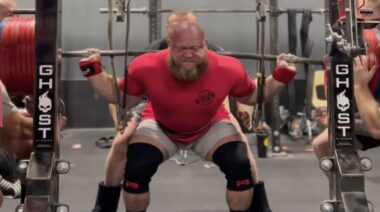We’ve all been frustrated with the half-squatters taking up time in the power rack. While they should perhaps be applauded for doing something other than sitting on their couches watching TV, they are taking up valuable rack time. A recent study in the Journal of Strength and Conditioning Research examined the results of regular half-repping.
Partial reps are not always considered poor form. Sometimes they are actually seen as beneficial. Many powerlifters, for example, will use partial reps to strengthen a portion of one of their competition lifts, especially where their sticking point is. Your sticking point in a lift – the point at which you fail at the rep – can be used to show where your weaknesses lie. If you use partial reps with just the right load to strengthen your weak spot, the lift can be improved.
Doing a half rep in the gym as your only means of performing an exercise is a little different from working out the kinks in your competition lifts. The researchers in the Journal study examined an exercise somewhere between the two. They used partial reps in the “terminal range of motion,” or terminal ROM. This means the partials were like the kind you’d see being done by a half-repper in the squat rack. However, in this study they were incorporated as part of a larger program that included full squats as well.
The researchers chose terminal ROM partials because they believe this exercise may be better for athletes. The forces found at knee angles greater than ninety degrees are more common in sports, and thus athletes may benefit more from a program that includes terminal ROM partial squats in addition to full ROM. This technique could add an effect similar to the use of bands or chains, which also places emphasis on the final portion of a rep.
The study lasted twelve weeks, the first five of which focused on familiarization and pre-testing. Before and after the final seven-week intervention, the participants were tested for numerous qualities of leg strength and power. These tests included several maximal squat tests (full and partial), isometric force at various knee angles, and impulse at various times and knee angles.
The participants were divided into two groups. One group performed seven weeks of full squats, twice per week, using six or seven sets of three to five reps. The other group performed almost an identical program, except that about half of each of the sets were partial reps.
Force development, impulse power, strength, and peak isometric force were all improved significantly more in the partial rep program compared to the full rep program. Not only that, but for the last half of the program, the partial rep group was able to move relatively more weight, which further enhanced their results. The compounding feature of these effects over time should speak for itself.
So partial reps don’t just have a legitimate claim as a method for lifters to employ – they may also be essential for greater success. This certainly seems true for the lifters in this study, but may also have better carryover to other athletes like sprinters. If you’re not incorporating partial squats into your program already, now is the time.
References:
1. Caleb Bazyler, et. al., “The Efficacy of Incorporating Partial Squats in Maximal Strength Training,” Journal of Strength and Conditioning Research, DOI: 10.1519/JSC.0000000000000465.
Photo courtesy of Becca Borawski Jenkins/Breaking Muscle.






